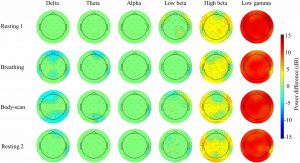Improve Worker Well-Being in Spite of Work-Life Conflicts with Mindfulness
By John M. de Castro, Ph.D.
“For many busy professionals, the phrase “work-life balance” can seem like an oxymoron. In today’s world of multi-tasking and 24/7 connectivity, work can seem omnipresent and overwhelming. How can you possibly maintain your competitive edge at work while also nurturing a healthy personal life? . . . Mindfulness can bring us back into balance by acting as a bridge between work and life.” – Dorsey Standish
Work is very important for our health and well-being. We spend approximately 25% of our adult lives at work. Indeed, the work environment has even become an important part of our social lives, with friendships and leisure time activities often attached to the people we work with. But work-related stress is epidemic in the western workplace. Almost two thirds of workers reporting high levels of stress at work. This stress can result in impaired health and can result in burnout; producing fatigue, cynicism, and professional inefficacy. To help overcome unhappiness, stress, and burnout, mindfulness practices have been implemented in the workplace. These mindfulness practices have been shown to markedly reduce the physiological and psychological responses to stress.
One of the stresses produced by the modern work environments results from work conflicting with the rest of the workers’ lives harming their well-being and mental health. But there is little understanding regarding how these conflicts affect the worker and what practices might help to mitigate the effects of work-life conflicts. Mindfulness helps to prevent the harmful effects of conflicts. So, it may help to blunt the effects of work-life conflict on the individual’s well-being.
In today’s Research News article “When Work Conflicts With Personal Projects: The Association of Work-Life Conflict With Worker Wellbeing and the Mediating Role of Mindfulness.” (See summary below or view the full text of the study at: https://www.frontiersin.org/articles/10.3389/fpsyg.2021.539582/full?utm_source=F-AAE&utm_medium=EMLF&utm_campaign=MRK_1771688_a0P58000000G0YfEAK_Psycho_20211111_arts_A ) Pacheco and colleagues recruited adult workers and had them complete a questionnaire measuring mindfulness, positive mental health, well-being in the workplace, personality, and work-life conflict, including time-based conflict and strain-based conflict..
They report that the higher the levels of mindfulness the higher the levels of positive mental health and well-being in the workplace and the lower the levels of time-based conflict and strain-based conflict. They also found that the higher the levels of both time-based conflict and strain-based conflict the lower the levels of positive mental health and well-being in the workplace.
Using linear structural modelling to assess the interrelationships between the variables they found that both time-based conflict and strain-based conflict were associated with lower well-being in the workplace directly and also indirectly by being associated with lower mindfulness which was associated with lower well-being in the workplace. They also found that both time-based conflict and strain-based conflict were associated with lower positive mental health only indirectly by being associated with lower mindfulness which was associated with lower positive mental health.
These findings are correlational. So, no conclusions regarding causation can be reached. But in previous controlled research mindfulness training has been shown to improve mental health and well-being. So, the relationships with mindfulness observed here are likely due to causal connections. The findings, then, suggest that the conflicts between work and life in general are factors in lowering workers’ mental health and well-being at work. The findings further suggest that mindfulness is an important intermediary where mindfulness is a promoter of positive mental health and well-being at work, but work-life conflicts reduce mindfulness. Future research should attempt to train mindfulness to observe whether it can mitigate the negative effects of work-life conflicts.
So, improve worker well-being in spite of work-life conflicts with mindfulness.
“[mindfulness] is effective for encouraging work–life balance and improve well-being.” – Sarah Elena Althammer
CMCS – Center for Mindfulness and Contemplative Studies
This and other Contemplative Studies posts are also available on Twitter @MindfulResearch
Study Summary
Pacheco T, Coulombe S and Meunier S (2021) When Work Conflicts With Personal Projects: The Association of Work-Life Conflict With Worker Wellbeing and the Mediating Role of Mindfulness. Front. Psychol. 12:539582. doi: 10.3389/fpsyg.2021.539582
The negative emotional and health effects of work-life conflict (WLC) have been demonstrated in numerous studies regarding organizational psychology and occupational health. However, little is known about WLC’s relationship with positive wellbeing outcomes, including emotional, psychological, and social aspects of workers’ thriving. Furthermore, the mediating processes underlying the effects of WLC remain mostly unknown. The current study investigated the associations of perceived time- and strain-based WLC with positive mental health and thriving at work, as well as the mediating role of mindfulness in these associations. It is argued that WLC causes reduced mindfulness capacities among workers, which is in turn associated with lower positive wellbeing given the importance of mindfulness in emotion regulation. A sample of 330 workers based in Québec, Canada, completed an online survey including a measure of strain- and time-based interference with personal projects (i.e., the goals and activities that define the daily life of an individual) and validated scales of wellbeing outcomes and mindfulness. Results of structural equation modeling revealed negative associations between time- and strain-based WLC with positive mental health and thriving at work. Work-life conflict was related to lower mindfulness, which played a mediating role in the associations between time-based WLC with positive mental health and thriving at work, as well as strain-based WLC with positive mental health. The mediation was complete for the time-based WLC and positive mental health association, but partial for the other mediated pathways, highlighting the need for more research to identify additional mediators. These results highlight that beyond resulting in negative emotional/health outcomes often studied in previous research, WLC may be associated with workers’ reduced potential to live a fulfilling life, in general and in the workplace. Recommendations (e.g., mindfulness intervention to promote emotional regulation, personal project intervention) for workplace policymakers and practitioners are identified.








